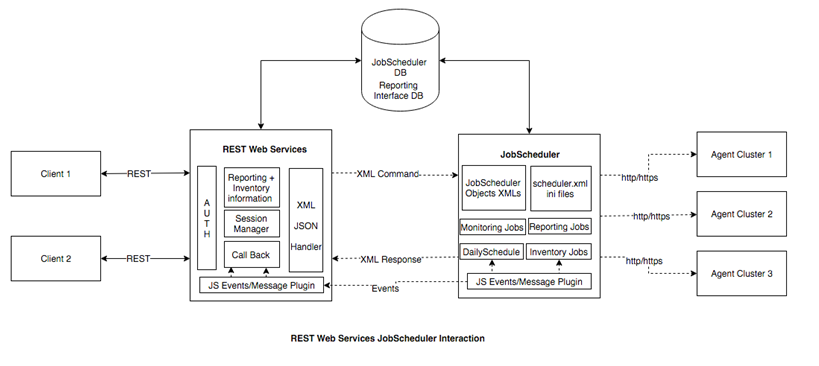Overview
The introduction of the JobScheduler Operating Center (JOC) Cockpit with the release of Version 1.11 brings a significant change in the JobScheduler architecture: The Web Services can be addressed by any number of Cockpit GUIs and by external programs such as ERP applications.
The diagram below provides a schematic view of a typical JobScheduler environment using the JOC Cockpit.
Additional features of this new architecture are:
- Authentication and Authorization: The Web Services use an LDAP Directory for authentication, authorization is carried out against role-based group permissions data held on the WebServices server. This means that user access to particular resources can be restricted and that resources .
- Multiple GUIs: The JobScheduler Web Services can be accessed by more than one Cockpit, so that, for example, an operator situated in a remote site can carry routine tasks at the same time as an administrator in the server room is configuring maintenance procedures.
- 3rd party applications: External applications such as ERP systems can also access the Web Services and, for example, start jobs when they provide the correct authentication and authorization.
- Multi-Client Capability: Any number of JobScheduler Masters can be controlled in a network via the Web Services as long as they are in the same network.
- Job Status and History: JobScheduler Masters record operational information in a database - this information can be called up from the JOC Cockpit via the Web Services.
Note also the following:
- The JOC Cockpit can display workplan and job history information and therefore functionally replaces JID - the JobScheduler Information Dashboard, which will not be delivered with the JobScheduler from version 1.11 onwards.
- JobScheduler Universal Agents or Universal Agent Clusters cannot be directly controlled via the Web Services - this must take place via a JobScheduler Master.
Technical Details
The diagram below shows the JobScheduler JOC Cockpit Architecture at a more technical level.
HTTP is used for communication between the RESTful Web Services and the JOC Cockpit - or other application - clients.
The Web Services use XML commands and responses to communicate with the JobScheduler Master(s). [Protokol??] In addition events are communicated [Protokol??] between the Web Services and the JobSchedulers.
Communication between the JobScheduler Masters and Agents takes place using HTTP/HTTPS RESTful web service .
Communication between the REST Web Services and the JobScheduler database takes place using XML [Genauer??] .
Authentication and authorization is carried out by an Apache Shiro framework integrated into the Cockpit:
- authentication is carried out against an LDAP directory (not shown in the technical diagram above but in the) and
- authorization is carried out against a role-based group permissions file.
